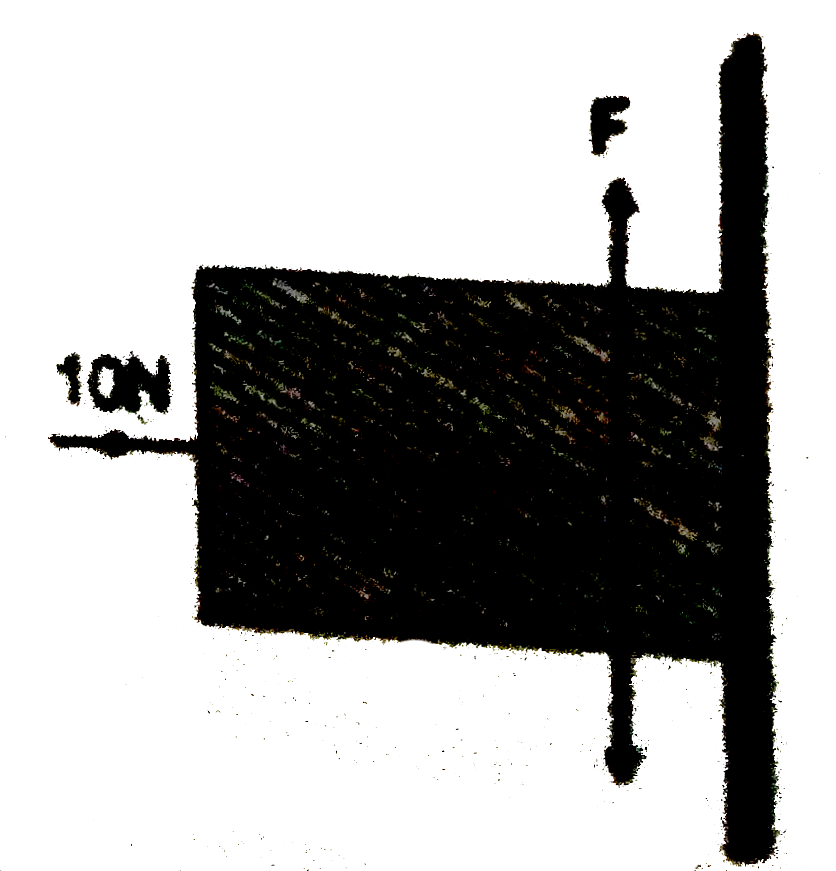A cubical block of mass M vibrates horizontally with amplitude of 4.0 cm and a frequency of 2.0 Hz. A small block of mass is placed on the bigger block. In order that the smaller block does not side on the bigger block, the minimum value of the coefficient of static friction between the two blocks is (0.16x). Find the valule of x(Take π2=10 and g=10m/s2)
0.36
0.4
0.64
0.72
The correct Answer is:C
To solve the problem, we need to find the minimum value of the coefficient of static friction (μ) between the two blocks so that the smaller block does not slide off the larger block. We will use the relationship between the maximum acceleration of the block in simple harmonic motion (SHM) and the gravitational force acting on the smaller block.
1. Identify the parameters:
- Amplitude A=4.0cm=0.04m
- Frequency f=2.0Hz
- Gravitational acceleration g=10m/s2
2. Calculate the angular frequency (ω):
ω=2πf
Substituting the frequency:
ω=2×3.14×2=12.56rad/s
3. Calculate the maximum acceleration (amax) in SHM:
The maximum acceleration is given by:
amax=ω2A
Substituting the values:
amax=(12.56)2×0.04
amax=158.1136×0.04=6.324544m/s2
4. Set up the inequality for static friction:
For the smaller block not to slide, the maximum static friction must be greater than or equal to the inertial force acting on it due to the acceleration:
μmg≥mamax
Dividing both sides by m (mass of the smaller block):
μg≥amax
5. Rearranging the inequality:
μ≥amaxg
6. Substituting the values:
μ≥6.32454410=0.6324544
7. Finding the value of x:
We are given that μ=0.16x. Therefore:
0.16x≥0.6324544
Solving for x:
x≥0.63245440.16≈3.96535
Rounding to two decimal places, we find:
x≈3.97
Final Answer:
The value of x is approximately 3.97.
- Amplitude A=4.0cm=0.04m
- Frequency f=2.0Hz
- Gravitational acceleration g=10m/s2
ω=2πf
Substituting the frequency:
ω=2×3.14×2=12.56rad/s
The maximum acceleration is given by:
amax=ω2A
Substituting the values:
amax=(12.56)2×0.04
amax=158.1136×0.04=6.324544m/s2
For the smaller block not to slide, the maximum static friction must be greater than or equal to the inertial force acting on it due to the acceleration:
μmg≥mamax
Dividing both sides by m (mass of the smaller block):
μg≥amax
μ≥amaxg
μ≥6.32454410=0.6324544
We are given that μ=0.16x. Therefore:
0.16x≥0.6324544
Solving for x:
x≥0.63245440.16≈3.96535
Rounding to two decimal places, we find:
x≈3.97
The value of x is approximately 3.97.
Similar Questions
A horizontal force of 20 N is applied to a block of mass 4 kg resting on a rough horizontal table. If the block does not move on the table, how much frictional force the table is applying on the block. What can be said about the coefficient of static friction between the block and the table? Takeg=10ms2.
View SolutionA force of 200N is applied as shown in the figure on block of 3 kg. The coefficient of friction between the block and the wall is 0.3. Find the friction acting on the block. (in N) {Take g = 10 m/s2
 View Solution
View Solution
Knowledge Check
- Question 1 - Select One
A block of mass 2 kg is placed on the floor. The coefficient of static friction is 0.4. A force F of 3 N is applied on the block as shown in figure. The force of friction between the block and the floor is (Take g=10ms−2)
 A3 NB8 NC4 ND6 N
A3 NB8 NC4 ND6 N
A block of mass M is being pulley along horizontal surface .The coefficient of friction the block and the surface is μ If another block of mass M/2 is placed on the block and it is pulled is again pulled on the surface , the coefficient of friction the block and the surface will be
View SolutionA 2kg block is placed over a 5kg block and both are placed on a smooth horizontal surface. The coefficient of friction between the blocks is 0.10. Find the acceleration of the two blocks if a horizontal force of 14N is applied to the upper block (g = 10ms−2).
View SolutionA horizontal force of 10 N is necessary to just hold a block stationary against a wall. The coefficient of friction between the block and the wall is 0.2. the weight of the block is (g=10m/s2)
 View Solution
View SolutionA block of mass 2 kg is placed on the floor. The coefficient of static friction it 0.4. A force F of 2.5 N is applied on the block, as shown. calculate the force of friction between the block and the floor. (g=9.8m/s2).
View SolutionA block of mass 1 kg is placed on a truck which accelerates with acceleration 5ms−2. The coefficient of static friction between the block and truck is 0.6. The frictional force acting on the block is
View SolutionA block of mass 2 kg is placed on the floor . The coefficient of static friction is 0.4 . If a force of 2.8 N is applied on the block parallel to floor , the force of friction between the block and floor is : (Taking g = 10m/s2)
View SolutionA block of mass 10 kg is placed on the rough horizontal surface. A pulling force F is acting on the block which makes an angle θ above the horizontal. If coefficient of friction between block and surface is 43 then minimum value of force required to just move the block is (g=10ms2)
View Solution

